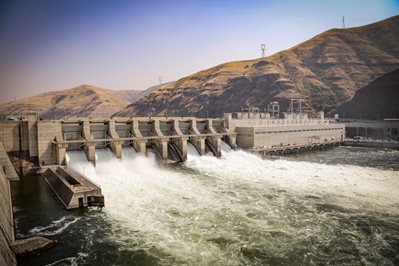Columbia River System
The Federal Columbia River Power System (FCRPS) comprises 31 hydroelectric projects in the Columbia River Basin, including the four Lower Snake River Dams (LSRD) which have fueled the region’s economic growth for more than 70 years. The LSRDs provide our region with low-cost power as well as irrigation, navigation and recreation. Learn more about the value of hydropower to our region.

The Bureau of Reclamation (Reclamation) and the U.S. Army Corps of Engineers (Corps) own and operate the federal projects. The Bonneville Power Administration (BPA) markets the power generated by the projects and distributes it through its transmission system.
Together, these three agencies are referred to as the Action Agencies.
Evaluation of the Columbia River System
In accordance with the National Environmental Policy Act, the Action Agencies completed a comprehensive analysis of six alternatives on flood risk management, water supply, hydropower generation, fish and wildlife, navigation, cultural resources, recreation and other environmental and socioeconomic effects. The Agencies identified a Preferred Alternative that seeks to achieve a reasonable balance of multiple river resource needs and agency mission requirements. One of the six alternatives the agencies evaluated included breaching the LSRDs. The Preferred Alternative concluded that the LSRDs were critical to providing affordable, reliable and clean energy for the Northwest and recommended maintaining them with adjusted operations.
The Action Agencies released a Record of Decision on the Columbia River System Operations Final Environmental Impact Statement (EIS) in September 2020.
Biological Opinion
To provide guidance for managing the effect of the FCRPS on endangered species NOAA Fisheries issues a Biological Opinion (BiOp). Under these BiOp, the federal agencies carry out a wide range of actions to help listed fish at all stages of their lifecycle.
In 2020, NOAA Fisheries’ released a Biological Opinion which examined the proposed hydroelectric operations under the EIS Preferred Alternative. It found that the recommended operations are consistent with the requirements of the Endangered Species Act.
Delayed Mortality
Delayed mortality is a theory that hypothesizes that young salmon encounters with dams causes cumulative trauma on their migration to the ocean. It is this trauma that results in death after the salmon has migrated passed the last dam and has made it into the estuary or ocean. While the Independent Scientific Advisory Board (ISAB), which is the region's salmon science equivalent to the National Academies of Sciences, Engieering, and Medicine agrees the hydro system causes some fish to experience delayed mortality, they have also concluded the magnitude of the impact of delayed mortality on salmon survival is highly uncertain and cannot be scientifically proven because there are too many dynamic variables in the ocean environment.
Study Links Salmon Decline to Ocean Conditions
A study by British Columbia scientist David Welch revealed that Chinook salmon survival has fallen by two-thirds, on average, for almost all regions along the western coast of North America - in both dammed and undammed areas - and not just in the Columbia River Basin. The research also reveals that survival is indistinguishable for Puget Sound and Snake River Spring Chinook populations, despite the absence of major dams in the Puget Sound region and goes on to blame ocean conditions instead of dams for the poor salmon returns.
A Synthesis of the Coast-wide Decline in Survival of West Coast Chinook Salmon
Support for the Snake River Dams
On June 25, 2020, Benton PUD Board of Commissioners passed a resolution in support of the Federal Columbia River Power System and the Four Lower Snake River Dams. The resolution expressed supports for the continued operation of the LSRDs due to their importance to the reliability of the Northwest electric grid as well as for the carbon-free, renewable, reliable, and low-cost energy they provide making them an important component of a clean energy future.
Learn more about the Snake River Dams
A Northwest energy solution: Regional power benefits of the lower Snake River dams - March 2016
Citizen's Guide to 2016 Comprehensive Evaluation: Protecting Salmon and Steelhead in the Columbia River Basin
Southern Resident Killer Whales and Snake River Dams - 2016
Southern Resident Killer Whales and West Coast Chinook Salmon - 2018
BPA invests in fish and wildlife - January 2019